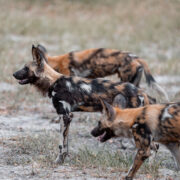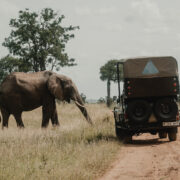Endangered Wildlife of Africa and Where to Find Them
The first thing that comes to mind when thinking of Africa is sunsets and wildlife. Yet, many animals that are synonymous with the continent are also classified as an Endangered species- meaning they are at a high risk of going extinct in the wild. Thanks to the continuous effort of national parks and conservations, these species are still around and hope to recover. This makes sightings of these animals in their natural habitat even more special and sought after.
If seeing any of these animals is a bucket list item, keep reading to see our tours that venture into their territories!
African Wild Dog
African Wild Dogs are the most successful apex predator, known for their gorgeous coats and big ears. They are a social species, looking after the sick or wounded and sharing child rearing amongst themselves. Due to their strong social bonds, they are very chatty creatures – yipping, barking, whining and howling. In the Kruger Park, they have been seen to vote through sneezing to decide whether or not a hunt will start. Despite their hunting expertise, many kills they make are stolen by lions or hyenas and reduced habitat has affected their hunting frequency.
They are mainly found in Southern Africa, primarily in Botswana, Namibia and lower Tanzania. They are also commonly sighted in the Kruger National Park.

African Savannah Elephant
A true icon of Africa, the African Savannah Elephant is the largest land animal in the world. Their rough grey skin weathers the sun and thorn trees, while their trunks function as both a nose and arm. They will use their trunks to pick leaves, put water in their mouths and feel the world around them. Due to their massive size, elephant herds will roam large distances to find food throughout the year.
This majestic animal is native to 23 countries in Africa with a population of approximately 415,000. The highest density of elephants are found in Botswana, having 31% of the total population, Zimbabwe, Tanzania and South Africa (specifically around the Kruger National Park).

Black Rhinoceros
While rhinoceros species in Africa have made miraculous recoveries from near extinction, the black rhinoceros are still critically endangered. Distinguished by their hooked upper lip and smaller size, the black rhino peruses leaves on lower hanging branches and bushes, as opposed to grazing on grass like their larger, square lipped cousins. Their temperament is infamous, having a habit of charging first and asking questions later, quickly reaching speeds of 55 k/h.
Currently, they can only be found in nature reserves, with 87% of the population spread across Namibia, Kenya and South Africa. One key site is Etosha National Park, where their populations are surveyed.

Pangolin
An unusual creature, the pangolin is a scaled insectivorous mammal that will roll into a ball to use its scales as protection and its tail as self-defence. All eight species, four of which are African, are protected. Due to the species being solitary and nocturnal, their population numbers are unknown, however two of these species are endangered and two are vulnerable in Africa. Because of their elusive nature and low numbers, sightings are very rare and would make any veteran guide’s year.
If you want to take a shot at seeing one, join a night game drive in Zimbabwe, near the Okavango Delta, Botswana, Mozambique, Malawi, or Tanzania. These are the higher density areas of the population where you are more likely to see them.

Mountain Gorillas
Very few animals can compare with the awe-inspiring Mountain Gorilla. With a small population of just over 1000, this ape species has a gentle nature despite their intelligence and strength. They are herbivores, travelling on the ground by walking on their knuckles through dense forests and jungles. Their extinction has been prevented due to active and consistent conservation efforts, remaining dependent on tourism and human intervention.
The gorillas are confined to Uganda, Rwanda and the Democratic Republic of Congo, with two major populations spread over three national parks. Gorilla trekking is an exceptional experience and a frequent highlight.

African Penguin
Once named after their braying calls, the African penguin is a highlight for any one of any age. Clumsy on land and fantastically graceful when swimming, these flightless birds have big personalities and have captured the hearts of locals and travellers alike. Exclusive to the south-western waters of Africa, there are only two colonies, one at Stoney Point in Betty’s Bay and another at Boulders Beach near Simon’s Town. These areas are both protected and offer sturdy boardwalks for travellers to admire and photograph the penguins.
Occasionally these penguins can be seen along Namibia’s coastline, but their colonies in South Africa are the best place to reliably view them.

Whale Shark
Didn’t expect a fish on this list, did you? The largest fish in the world, aside from true whale species, this shark is known for its speckled skin and docile nature. A filter feeder and one of three known filter-feeding shark species, they make superb and safe snorkeling buddies. They roam warm, tropical waters and are migratory, seasonally grouping for food in specific regions.
These majestic sea creatures have two subpopulations: the Atlantic and Info-Pacific. Within Africa, their preferred seasonal feeding regions are around Tanzania’s Mafia Islands and Mozambique’s province of Inhambane, but they can be sighted all along Africa’s Eastern coast, even down to Cape Agulhas in South Africa.

Golden Monkey
An elusive creature, Golden Monkeys are confined to the Virunga Mountains, residing alongside their much larger cousins, the Gorillas. Due to their limited habitat and the threats in and around it, these monkeys have dwindled and are listed as endangered. While they favour fruits when in season, their diet mainly consists of bamboo and they prefer to stay in bamboo forests. Using the leafier canopies of the bamboo, they create sleeping areas and will return to it after feeding.
While the monkeys are exclusive to the area, the Virunga Mountains span into Uganda, Rwanda and the Democratic Republic of Congo.

Where to Go
You’ve got many options if you want to see multiple species on this list. Several national parks and game reserves boast endangered species and help to protect and conserve the enchanting nature of Africa. The best chances, looking at higher wildlife density regions, would be Botswana’s Okavango Delta, Zambia’s Zambezi (Caprivi) Strip, Tanzania’s Serengeti and Ngorongoro Crater, and Southern Africa’s world-renowned Kruger National Park.
Guarantees are not possible in these gorgeous wilderness areas, however do keep in mind that many reserves and national parks have conservation programs on site, such as Hwange’s wild dogs and Addo’s elephants.
Area restricted species, like the gorillas, golden monkeys and African penguins, can only be found in their named countries.



